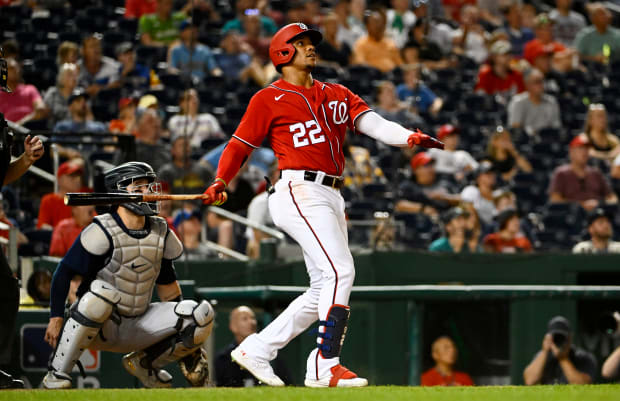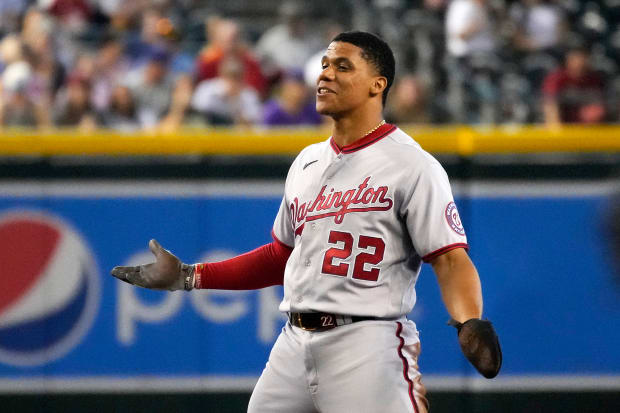Welcome to The Opener, where every weekday morning during the regular season you’ll get a fresh, topical story to start your day from one of SI.com’s MLB writers.
With each dwindling day, as they take calls from half the teams in baseball, the Nationals face a stark reality: they will have made a big mistake if Juan Soto is still on their team Aug. 3.
“At this point I would be very surprised if he’s still there after the [trade] deadline,” says one NL executive. “It’s more likely than not that he is going to be traded.”
We are looking at an all-time blockbuster trade. Soto, 23, is the unicorn of trade chips. No one this young, this historically great and this far from free agency (2 1/2 years) has been traded. But here is why the mega-deal is likely in the next seven days:

Brad Mills/USA TODAY Sports
1. Washington has no chance of signing him to an extension. The Nationals offered him $440 million, which is a staggering amount, but on an annual basis over 15 years would pay him 16% less than what the Angels are paying Anthony Rendon.
Soto will be 26 years old when he is eligible for free agency after the 2024 season. His agent, Scott Boras, knows nothing is more valuable than an elite player hitting free agency at such a young age (Alex Rodriguez, Bryce Harper, Manny Machado, etc.). Soto has a career OPS+ of 160 at age 23. Only four other hitters have been this good this young with 2,000 plate appearances: Ted Williams, Ty Cobb, Mike Trout and Albert Pujols. Soto will be the first to bring his historic start to free agency in his 20s.
2. The Nationals are the worst team in baseball with one of the worst farm systems. They are not contending with Soto over his last two-and-a-half years of control.
3. The team is being sold. There is no way Soto is committing his prime years to a franchise in which the owner and direction are unknown. Moreover, “Just about every owner does not want the headache and PR hit of having to trade the team’s best player immediately after buying the team,” the executive said. “They prefer to have the problem removed.”
4. Soto’s value immediately goes down on Aug. 3 if he is still a National. Once the deadline passes, Soto can affect only two pennant races instead of three.
5. The interest in Soto is off the charts. In addition to the trade package, Soto will cost a team about $5.3 million for the remainder of this season and about $55 million for his final two arbitration seasons. The Twins are paying Carlos Correa $81 million over the same 2 ½ years. Every team with the hope of winning the World Series in this three-year window must be in on Soto—including the Guardians and Rays.
Cleveland and Tampa Bay? Yes. The pool is that deep.
Start with the obvious teams that are never out of a bidding war because of their resources: the Yankees, Dodgers, Red Sox and Cubs.
Add teams with new ownership who are willing to mortgage the long-term cost to seize this three-season window for a long-awaited World Series championship: the Mets, Padres and Guardians. Never discount new owner motivation as the X factor in these kinds of deals. And add the Rays to this group, not because the ownership is new but because they are desperate to generate momentum toward a new ballpark somewhere. (See their free agent interest in Freddie Freeman.)
“Cleveland and Tampa Bay both have the need and, more importantly, the young talent to get a deal done,” the executive says. “I would count them among a lot of teams in play.”
Cleveland (1948) and the Rangers, Brewers, Padres and Mariners (never) have the longest World Series title droughts. Tampa Bay, a newer franchise than the five others mentioned above, also never has won one. No way those teams should be sitting out the chance to acquire a generational talent who can give them three shots at a championship. (Milwaukee has been home to a World Series-winning team, when the Braves beat the Yankees in 1957, less than a decade before moving to Atlanta.)
Add the Cardinals, who have the most major-league ready young talent to trade, the Blue Jays, who were built to win in this three-year window, and the Giants, a fading contender that needs a new star, and you have half the teams in baseball with which Washington GM Mike Rizzo can create a bidding war.
Ultimately, Rizzo, a former scout, will choose the elite young talent he most wants and then finish a deal with others. What will it take to get Soto? Start with a team’s best prospect. Soto is too good and the field too crowded for Rizzo to make this deal without getting a club’s No. 1 prospect. It also will take four other elite prospects, or three if a team is willing to take on a chunk of the $67 million owed pitcher Patrick Corbin.

AP Photo/Rick Scuteri
History gives us some clue of what it will take, although keep in mind the midseason trade market has never seen a player this great with so many years of control and so many teams in play. Ken Griffey Jr. was 30 years old with veto power when Seattle traded him before the 2000 season. Mookie Betts also was traded before a season, with only one year of control and when he was four years older than Soto is now. Giancarlo Stanton was an offseason salary dump with trade veto restrictions. Randy Johnson (Mariners to Astros in 1998), C.C. Sabathia (Cleveland to Milwaukee in ‘08) and Max Scherzer (Nationals to Dodgers last year) were rentals. The Scherzer trade also sent All-Star shortstop Trea Turner, who had one more year of control, to Los Angeles. None of these are comparable to the Soto sweepstakes. He presents the opportunity for the biggest trade deadline blockbuster ever seen.
To get an idea of what the return might be in a Soto deal, I chose the three biggest deadline blockbusters this century that involved superstars with multiple years of control. I also added the 2007 deal that sent Miguel Cabrera from the Marlins to the Tigers, even though that was a December deal, because Cabrera is the most recent of rare trade value comps to Soto in terms of age (Cabrera was 24), years of control (two) and OPS+ (143).
The takeaway for buyers: a package of four or five players is worth taking a shot at the World Series. For the seller: make sure you get a No. 1 prospect in a package deal, but don’t expect to “win” a deal in which you give up generational talent. For Rizzo: the clock is ticking to make the trade of the century.
Curt Schilling, Philadelphia to Arizona, July 2000
Age: 33
Number of pennant races under control: 2
World Series payoff? Yes. The Diamondbacks won their first and only title the following season.
The price: Four major leaguers: Vicente Padilla, 22, Travis Lee, 25, Nelson Figueroa, 26, Omar Daal, 28.
No. 1 prospect included? No.
Verdict for seller: Phillies GM Ed Wade got burned by taking the “safer” route of major-league ready players. None had high ceilings.
Bartolo Colon, Cleveland to Montreal, June 2002
Age: 29
Number of pennant races under control: 2
World Series payoff? No.
The price: Three prospects and a veteran: Grady Sizemore, 20; Brandon Phillips, 21, Cliff Lee, 23, Lee Stevens, 34.
No. 1 prospect included? Yes: Phillips.
Verdict for seller: A win for then rookie GM Mark Shapiro, who identified three future All-Stars.
Mark Teixeira, Texas to Atlanta, July 2007
Age: 27
Number of pennant races under control: 2
World Series payoff? No.
The price: Four young prospects: Elvis Andrus, 18, Neftali Feliz, 19, Matt Harrison, 22, Jarrod Saltalamacchia, 22
No. 1 prospect included? Yes: Saltalamacchia. Texas obtained four of the Braves’ top five prospects.
Verdict for seller: GM Jon Daniels hit paydirt, finding building blocks for the first Rangers team to reach the World Series, in 2010. They won the AL pennant the next year, too, but have not made it back to the Fall Classic since.
Miguel Cabrera, Florida to Detroit, December 2007
Age: 24
Number of pennant races under control: 2
World Series payoff? Yes, but only with contract extension. The Tigers reached the World Series in 2012, but lost to the Giants.
The price: Two top prospects and four fringe prospects, headlined by Cameron Maybin, 20, and Andrew Miller, 22. (Dontrelle Willis also went with Cabrera.)
No. 1 prospect included? Yes: Maybin. He and Miller were ranked in the top 10 of all MLB prospects.







